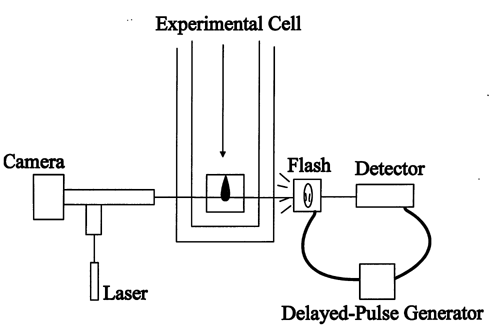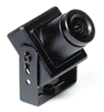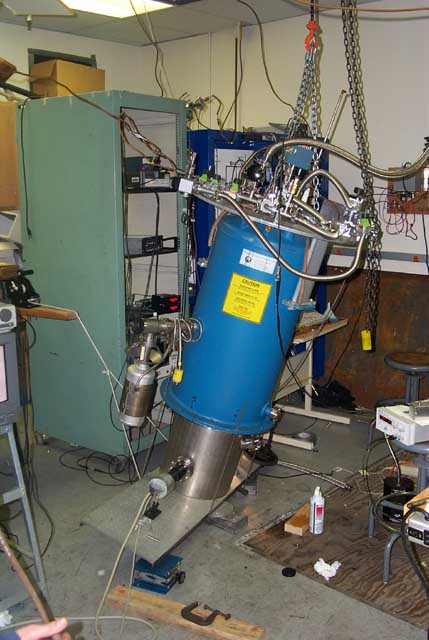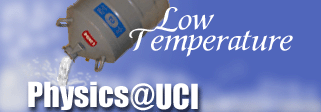 |
Latest News
We have a YouTube Channel.
|
|
|
|
| Dr. Taborek
|
|
|
| Publications |
|
|
| Students |
|
|
| Postdocs |
|
|
|
|
|
Alumni |
|
|
| Current Research |
|
|
| Contact Us |
|
|
Handbook  |
|
|
|
|
|
| UCI
|
|
|
| Physical Sciences |
|
|
| Physics Dept. |
|
|
|
|
|
|
 |
| |

- How were the helium pinch-off pictures taken?
- A Kodak DCS315 Professional digital still camera was
attached to a long range microscope outside the cryostat
and focused on the pinch-off location.
From the camera mount, a 630nm laser beam is redirected
out of the microscope aperture, where it passes under the
pinch-off location, and enters a photodetector on the
opposite side of the cryostat. A blue glass notch filter
is used to attenuate the partial transmission of red
laser light into the camera. The image of the drop is
allowed to pass through this attenuating filter. 630nm
red light is removed, giving the image a blue tint.
The disruption of the laser beam by the falling drop
triggers the xenon flashlamp.

By installing a delayed pulse generator between the
photodiode and the flashlamp, several photographs of the
drop in various stages of pinch-off can be easily
obtained, allowing the frames to be pieced together into
a video clip.
- How do QCMs (Quartz Crystal Microbalances) work?
- Quartz is a material that exhibits piezoelectric behavior;
that is, an applied voltage to the crystal causes a physical
distortion of the material. Likewise, a physical distortion
of the crystal produces a voltage.

When an AC voltage is applied to a QCM such that its frequency
matches the resonant frequency of the crystal, a standing wave
is established in the crystal. When a mass is applied to the
crystal, as would occur in film deposition, or allowing droplets
of liquids to exist on its surface, the resonant frequency of
the crystal drops. The drop in frequency is linearly
proportional to the mass coupled to the crystal's oscillation.
The employment of some clever mathematics will convert this
drop in frequency into a known mass.
- Why not put the camera inside the cryostat?
- Outwardly, it seems like a good idea. Why fuss with all the
expense of mounting windows and just put the electronics inside the
cryostat itself?

The reason we can't do this is because at the temperatures our
experiments take place, which is about -456║ F, all electronics
that involve semiconductors, such as CCD cameras, turn into
electric insulators, rendering them useless.
- Liquid helium boils at 4.2K. How do you achieve temperatures lower than this?
- Helium-4 evaporative cooling: - Liquid helium can be cooled from its boiling
point by pumping on the bath of liquid helium. Using this method alone, temperatures
as low as 1K can be achieved. For anything less, other methods must be employed.
- Helium-3 evaporative cooling- 3He is expensive (about $200 per STP liter of gas),
and efforts to recycle the evaporated gas must be employed. Temperatures as low as
about 400mK can be obtained with this method.
- He3-He4 dilution refrigeration- about 100mK
- Adiabatic spin demagnetization: paramagnetic salt- <10mK
- Adiabatic nuclear demagnetization- <1ÁK
- How did you tilt the cryostat in those sliding droplets videos?
- We held the dewar aloft with a chain hoist while ratcheting a rope tied to the base of
the cryostat and proceeded to hold our breath!

|
|
|
|
|
| All material on this site is the intellectual property of the Taborek/Rutledge research group. |
|
